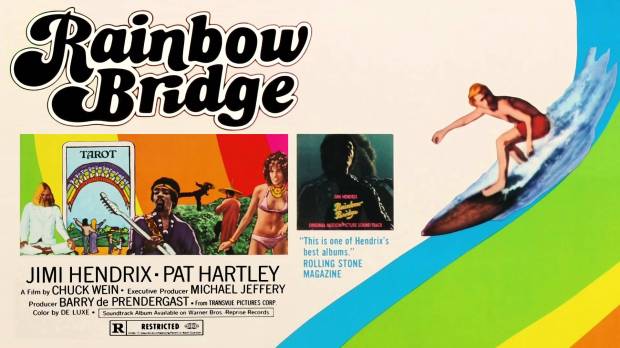Rainbow Bridge
Directed by Chuck Wein—1971—125 minutes
Develop a rough idea for a film project, gather together some people to be in it, and then switch on the camera. While this may be a viable plan of action for first year film-school kids, it’s not usually recommended for a high profile project. But amazingly, the motion picture division of Warner Bros. greenlighted two such counterculture projects in 1970: the first was the stillborn documentary “Medicine Ball Caravan” the fascinating backstory of which was my first ever blogpost HERE. The other was the similarly fuzzy “Rainbow Bridge.” Of course, WB had just hit the hippie jackpot with the Woodstock film, which was a box-office smash and eventual Oscar winner for best feature documentary. But to think one could replicate that success without minimal effort was indicative that Hollywood hadn’t evolved its thinking about “youth movies.” When the producers of “Rainbow Bridge,” who included people involved in the management of Jimi Hendrix, saw what they had in the can after burning thru their initial $450,000 budget, they practically begged the legendary guitarist, already on board for the soundtrack, to appear in some specially-arranged concert footage as well. But it would not be enough to save it and the days of the flower-power genre were numbered.

Jimi Hendrix at the Rainbow Bridge concert in Maui, July 1970
“Rainbow Bridge” starts with a blank black screen and a deep important-sounding male voice telling us how the “New Young” are going to bring peace to our planet. Instead, all we get are the inconsequential wanderings of a bright but unremarkable woman named Pat Hartley, who we watch cavorting aimlessly around Los Angeles. Both Hartley and the director, Chuck Wein, were associated with the Andy Warhol Factory scene but what we end up with here is worlds away from the NYC demimonde. The story arc, such as it is, has Hartley flying to Hawaii, where the bumming around re-commences. She ends up at the Rainbow Bridge Occult Research Meditation Center and the inane pseudo-New Age babbling begins. I won’t bore you with the details, as you can bore yourself silly by checking it out yourself: the film is currently available in nine separate parts on YouTube. But a typical eye-roller is when one of the gurus claims he feels “heavy reincarnation vibes from everyone in this room. “ As if one go-around weren’t enough with this crowd. Primarily, “Rainbow Bridge” seems to exist is to confirm the suspicion that no matter how earnest the striving for enlightenment, communal life among the Sixties crowd were just as often marked by petty in-fighting and major dope deals.

Pat Hartley
An hour and twenty minutes of this seems like two lifetimes, so maybe the reincarnation angle isn’t far off. During this stretch, the only highlights have been a few Hendrix songs on the soundtrack (notably “Dolly Dagger” and “Ezy Rider”) played to the antics of a free-spirited Pat Hartley or the wave-catching activities of some surfing/meditating hash freaks. With two-thirds of the film gone, Jimi shows up to lend some much needed credibility to the proceedings. And some entertainment value, too: I enjoyed the scene where our rock star hero play acts a scene where Hendrix brandishes a rifle then shoots one of the self-proclaimed “wizards” from an upper floor window. Adding up that scene, the concert sequence and a stoned conversation he has with Wein and Hartley, Hendrix is only present for probably a little less than 25 minutes of this interminable movie.
This is about all you would need to see of the film. The man himself, playing and rapping back at the house.
But luckily for us in the Internet and home video age, the live performance can be picked out piecemeal from the rest of “Rainbow Bridge” which is more than can be said of the poor ticket-buyers during the film’s original (and brief) theatrical run.Because of the windy conditions that day on the slopes of Maui’s long-dormant Haleakala volcano, a lot of Hendrix’s set was deemed unusable but what remains is well worth seeing, at least in isolation. Accompanied by Mitch Mitchell on drums and Billy Cox on bass, he plays a vigorous set for the few hundred appreciative freaks who got word of the hastily-arranged free show. Highlights are “Voodoo Chile,” “Hear My Train a-Coming” and “Purple Haze,” the latter featuring one of the better displays of Jimi playing guitar with his teeth.
This is the trailer to “Rainbow Bridge.” Consider that a fair warning.
Contrary to the trailer’s claim, this was not exactly Hendrix’s last concert on U.S. soil (he played a gig in Honolulu a couple of days later) but anyone aware of the chronology knows the end is near for one of rock’s greatest icons. Hendrix has barely six weeks to live as we hear him talk of an out-of-body experience. The risky hedonism of a drug-suffused counterculture is of course not a subject to be reckoned with in a film such as this, making the “Rainbow Bridge’s” semi-documentary intentions a bit of a joke. At the end, we are stuck again with the sanctimonious seekers, meeting with a woman who claims to have met with some liberating space aliens and that they “approve of LSD.” Whereas once upon a time this may have elicited whispers of “oh wow” there are many more nowadays ready with a raised hand and quick riposte of “Bye, Felicia.”
My latest book Rock Docs: A Fifty-Year Cinematic Journey is now available! And now you can try-before-you-buy, click on the link below to go to my author page and view a 30-page excerpt. http://booklocker.com/books/8905.html
Thanks! Rick Ouellette



